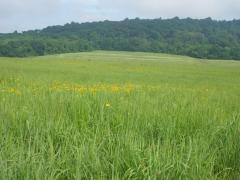American Kestrel
Although the American kestrel is widespread, meaning they live year round throughout much of the United States, the northeastern kestrel population is declining.
 Zoom+ The kestrel is the most common falcon in North America. In New Jersey, habitat loss and fragmentation threaten their survival. © Jim Gilbert
Zoom+ The kestrel is the most common falcon in North America. In New Jersey, habitat loss and fragmentation threaten their survival. © Jim Gilbert
The American kestrel (kestrel) is the smallest, most beautiful and widespread falcon in North America and one of two falcon species that nest in New Jersey. Kestrels are colorful birds of prey about the size of a mourning dove. American kestrels have reddish-brown backs and tails, blue-gray crowns with variable amounts of rusty color, and two vertical stripes on the sides of their heads. They have two dark “eyespots” on the back of their head. Male kestrels have blue-gray wings while females have reddish brown wings with black barring.
Although the American kestrel is widespread, meaning they live year round throughout much of the United States, the northeastern kestrel population is declining. Today, the kestrel is listed as a threatened species.
Kestrels are found in open, grassy habitats – especially ones that have cavities for nesting and perches for hunting. Kestrels can be seen hovering in grasslands, pastures and parklands or perched along the road on telephone lines. The decline of kestrels in New Jersey is likely due to destruction of grasslands from development. Also, nesting cavities are lost. As we clean up our fields, we remove trees with nest cavities the kestrels use.
The decline of kestrels in New Jersey is likely due to destruction of grasslands from development
American kestrels are versatile, opportunistic hunters feeding on assorted small prey, such as grasshoppers, lizards, mice, snakes and small birds. Unlike peregrine falcons, kestrels don’t use velocity to kill their prey. They perch to see their prey and then they use a stationary, hovering flight that allows them to dive down short distances to capture their prey. The eyespots on the back of their heads provide protection from other aerial predators, like Cooper’s hawks. The eyespots make it appear that the kestrel is “looking” up at the predator causing it to move on to find a less alert victim. The eyespots allow the kestrel to focus on hunting for the prey beneath them.
Researchers have not determined the exact reason for kestrel declines but, we do know that the availability of cavities for nesting appears to be a limiting factor. Kestrels are secondary cavity nesters. They don’t make their own cavity but use existing natural or man-made cavities. They prefer nest sites surrounded by suitable hunting grounds with unobstructed entrances. Kestrels nest in buildings and other man-made structures including nest boxes. Nest-box programs are an effective management option to grow the number of kestrels in areas where nest sites are limited.
 Zoom+ Grasslands are essential habitat for many species of wildlife. Throughout New Jersey they under constant the threat of being replaced with housing developments. © MacKenzie Hall
Zoom+ Grasslands are essential habitat for many species of wildlife. Throughout New Jersey they under constant the threat of being replaced with housing developments. © MacKenzie Hall
Conserve Wildlife Foundation of New Jersey, in partnership with the Endangered and Nongame Species Program implemented a nest box installation and monitoring program in 2006. Nest boxes have been erected in three geographic areas in habitat determined to be suitable for kestrels. The boxes are monitored by biologists during the breeding season. Because kestrels reuse nest sites particularly if they have successfully raised young, we focus on boxes that have been successful at least once since 2006. Currently, 139 boxes are being monitored by staff and volunteers. In 2010, 38 boxes were used by kestrels and we banded 62 fledglings.
In New Jersey, kestrels lay 4-7 (average of 5) eggs as early as late April and incubate them for about 30 days. Females do most of the incubating and males bring food to them. After the chicks hatch, the male brings food to the female who then feeds the chicks. The chicks grow quickly; in about 30 days they go from helpless fuzzy, down-covered chicks to fully feathered fledglings. After fledging, the adults continue to feed their young for several weeks. Less than a month after fledging, young kestrels leave the nesting area to begin life on their own.
The nest box program in New Jersey appears to be successful; we are adding to the population. Since 2006, we have banded over 300 fledglings. The kestrel you see hovering over a field may be one from our nest box program!
written by Kim Korth, LIP Project Manager, Endangered and Nongame Species Program, NJ Division of Fish and Wildlife
Find Related Info: Grassland birds, Raptors, Special concern






